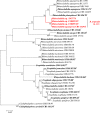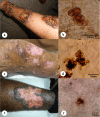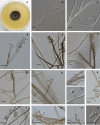Molecular Epidemiology of Agents of Human Chromoblastomycosis in Brazil with the Description of Two Novel Species
- PMID: 27893750
- PMCID: PMC5125572
- DOI: 10.1371/journal.pntd.0005102
Molecular Epidemiology of Agents of Human Chromoblastomycosis in Brazil with the Description of Two Novel Species
Erratum in
-
Correction: Molecular Epidemiology of Agents of Human Chromoblastomycosis in Brazil with the Description of Two Novel Species.PLoS Negl Trop Dis. 2017 Jan 25;11(1):e0005315. doi: 10.1371/journal.pntd.0005315. eCollection 2017 Jan. PLoS Negl Trop Dis. 2017. PMID: 28122015 Free PMC article.
Abstract
The human mutilating disease chromoblastomycosis is caused by melanized members of the order Chaetothyriales. To assess population diversity among 123 clinical strains of agents of the disease in Brazil we applied sequencing of the rDNA internal transcribed spacer region, and partial cell division cycle and β-tubulin genes. Strains studied were limited to three clusters divided over the single family Herpotrichiellaceae known to comprise agents of the disease. A Fonsecaea cluster contained the most important agents, among which F. pedrosoi was prevalent with 80% of the total set of strains, followed by 13% for F. monophora, 3% for F. nubica, and a single isolate of F. pugnacius. Additional agents, among which two novel species, were located among members of the genus Rhinocladiella and Cyphellophora, with frequencies of 3% and 1%, respectively.
Conflict of interest statement
The authors have declared that no competing interests exist.
Figures







References
-
- Silva JP, de Souza W, Rozental S (1998) Chromoblastomycosis: a retrospective study of 325 cases on Amazonic Region (Brazil). Mycopathologia 143:171–175. - PubMed
-
- Bayles MA (1986) Chromomycosis In Hay RJ (ed.), Baillie`re’s Clinical Tropical Medicine and Comunicable Diseases. Tropical Fungal Infections. London: WB Saunders, 1986: 45–70.
-
- Esterre P, Pecarrère JL, Raharisolo C, Huerre M (1999) Squamous cell carcinoma arising from chromomycosis. Report of two cases. Ann Pathol 19:516–520. - PubMed
Publication types
MeSH terms
Substances
LinkOut - more resources
Full Text Sources
Other Literature Sources
Molecular Biology Databases

